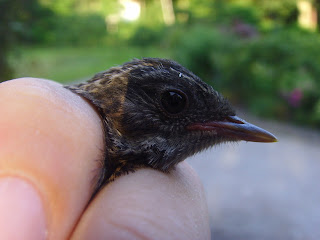Just realised that I haven't blogged about the two most recent
WeBS counts for Linacre ,so here goes.
First up is the July walk. I wasn't around for this walk, but, as usual, members of the
Chesterfield RSPB Group were, and they recorded the following:
Mallard (70; 40 adults and 30 young),
Mandarin Duck (8),
Moorhen (6, all adults),
Coot (20; 13 adults and 7 young),
Great-crested Grebe (9; 2 adults and 7 young),
Little Grebe (1 adult),
Tufted Duck (5),
Canada Goose (1),
Grey Heron (1), and the site's first July record of
Black-headed Gull!!
August's records are a combination of two walks.The first was carried out by Barbara from the RSPB Group (thanks) and I managed to get down yesterday morning for a few hours as well. Unfortunately Barbara's walk was spoilt by heavy rain, but I was more fortunate and managed to stay dry. The results were:
Mallard (52),
Mandarin Duck (11),
Moorhen (4; 3 adults and 1 youngster),
Coot (15; 12 adults and 3 young),
Great-crested Grebe (5; 2 adults and 3 young),
Little Grebe (4;1 adult and 3 young),
Tufted Duck (20),
Canada Goose (4),
Grey Heron (1) and
Grey Wagtail (heard).
As you can see, the results are similar for both months. The highlight for me was seeing the juvenile
Little Grebes, as I didn't think they'd breed this year. The pair had been seen on a nest in June, but this was presumably predated as no young were seen. They were then seen on a new nest at the end of July, and the 3 very young chicks were seen yesterday. Hopefully they'll survive and thrive. Here's a picture of the 2011 birds which bred out in the open. Perhaps this year's birds are the same pair?
2011 nest at Linacre
As well as carrying out the WeBS count, I also checked the tit boxes for the last time to see if any of this year's young had died before fledging. I'm very pleased to tell you that of the 166 chicks ringed (129 Blue Tits and 37 Great Tits) just 1 was found dead in the boxes - a very good fledging rate of 99.4%!
Whilst checking the boxes I also came across 4 Brown Long-eared Bats and a Shrew species, which I think was a Common Shrew.



















































